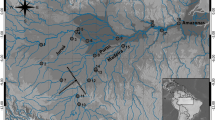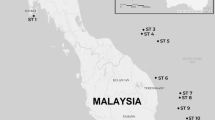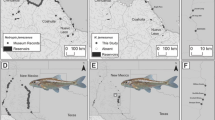Abstract
Northern Australia is considered to be one of the last strongholds for three critically endangered sawfishes, Pristis zijsron, Pristis clavata, and Pristis microdon, making these populations of global significance. Population structure and levels of genetic diversity were assessed for each species across northern Australia using a portion of the mitochondrial control region. Statistically significant genetic structure was detected in all three species, although it was higher in P. microdon (F ST = 0.811; N = 149) than in either P. clavata (F ST = 0.419; N = 73) or P. zijsron (F ST = 0.202; N = 49), possibly due to a much higher and/or localized level of female philopatry in P. microdon. The overall levels of haplotype diversity in P. zijsron (h = 0.555), P. clavata (h = 0.489), and P. microdon (h = 0.650) were moderate, although it appears to be reduced in the assemblages of P. zijsron and P. clavata in the Gulf of Carpentaria (h = 0.342 and h = 0.083, respectively). Since female migration (replenishment) between regions is unlikely, conservation plans should strive to maintain current levels of diversity and abundances in the regional assemblages of each species.


Similar content being viewed by others
References
Amos W, Balmford A (2001) When does conservation genetics matter? Heredity 87:257–265
Bruce BD, Stevens JD, Malcolm H (2006) Movements and swimming behaviour of white sharks (Carcharodon carcharias) in Australian waters. Mar Biol 150:161–172. doi:10.1007/s00227-006-0325-1
Castro ALF, Stewart BS, Wilson SG, Hueter RE, Meekan MG, Motta PJ (2007) Population genetic structure of earth’s largest fish, the whale shark (Rhincodon typus). Mol Ecol 16:5183–5192. doi:10.1111/j.1365-294X.2007.03597.x
Clement M, Posada D, Crandall KA (2000) TCS: a computer program to estimate gene genealogies. Mol Ecol 9:1657–1659
Daly-Engel TS, Grubbs RD, Feldheim KA, Bowen BW, Toonen RJ (2010) Is multiple mating beneficial or unavoidable? Low multiple paternity and genetic diversity in the shortspine spurdog Squalus mitsukurii. Mar Ecol Prog Ser 403:255–267. doi:10.3354/meps08417
DiBattista JD, Feldheim KA, Gruber SH, Hendry AP (2008) Are indirect genetic benefits associated with polyandry? Testing predictions in a natural population of lemon sharks. Mol Ecol 17:783–795. doi:10.1111/j.1365-294X.2007.03623.x
Dudgeon CL, Broderick D, Ovenden JR (2009) IUCN classification zones concord with, but underestimate, the population genetic structure of the zebra shark Stegostoma fasciatum in the Indo-West Pacific. Mol Ecol 18:248–261. doi:10.1111/j.1365-294X.2008.04025.x
Duncan KM, Martin AP, Bowen BW, de Couet HG (2006) Global phylogeography of the scalloped hammerhead Sphyrna lewini. Mol Ecol 15:2239–2251. doi:10.1111/j.1365-294X.2006.02933.x
Excoffier L, Laval G, Schneider S (2005) Arelquin version 3.0: an integrated software package for population genetics data analysis. Evol Bioinform Online 1:47–50
Feldheim KA, Gruber SH, Ashley MV (2001) Population genetic structure of the lemon shark (Negaprion brevirostris) in the western Atlantic: DNA microsatellite variation. Mol Ecol 10:295–303
Feldheim KA, Gruber SH, Ashley MV (2002) The breeding biology of lemon sharks at a tropical nursery lagoon. Proc R Soc Biol Sci Lond Ser B 269:1655–1661
Fu YX (1997) Statistical tests of neutrality against population growth, hitchhiking and background selection. Genetics 147:915–925
Goudet J (2002) Fstat, a program to estimate and test gene diversities and fixation indices (version 2.9.3.2). Available from http://www2.unil.ch/popgen/softwares/fstat.htm
Grant WS, Bowen BW (1998) Shallow population histories in deep evolutionary lineages of marine fishes: insights from sardine and anchovies and lessons for conservation. J Hered 89:415–426
Gu X, Zhang J (1997) A simple method for estimating the parameter of substitution rate variation among sites. Mol Biol Evol 14:1106–1113
Hailer F, Helander B, Folkestad AO et al (2006) Bottlenecked but long-lived: high genetic diversity retained in white-tailed eagles upon recovery from population decline. Biol Lett 2:316–319. doi:10.1098/rsbl.2006.0453
Hauser L, Adcock GJ, Smith PJ, Bernal Ramirez JH, Carvalho GR (2002) Loss of microsatellite diversity and low effective population size in an overexploited population of New Zealand snapper (Pagrus auratus). Proc Natl Acad Sci 99:11742–11747. doi:10.1073/pnas.172242899
Hoelzel AR, Shivji MS, Magnussen J, Francis MP (2006) Low worldwide genetic diversity in the basking shark (Cetorhinus maximus). Biol Lett 2:639–642. doi:10.1098/rsbl.2006.0513
Hueter RE, Heupel MR, Heist EJ, Keeney DB (2004) Evidence of philopatry in sharks and implications for the management of shark fisheries. J Northw Atl Fish Sci 35:239–247
Jenkins DG, Brescacin CR, Duxbury CV et al (2007) Does size matter for dispersal distance? Glob Ecol Biogeogr 16:415–425. doi:10.1111/j.1466-8238.2007.00312.x
Jost L (2008) GST and its relatives do not measure differentiation. Mol Ecol 17:4015–4026. doi:10.1111/j.1365-294X.2008.03887.x
Keeney DB, Heist EJ (2006) Worldwide phylogeography of the blacktip shark (Carcharhinus limbatus) inferred from mitochondrial DNA reveals isolation of western Atlantic populations coupled with recent Pacific dispersal. Mol Ecol 15:3669–3679. doi:10.1111/j.1365-294X.2006.03036.x
Keeney DB, Heupel MR, Hueter RC, Heist EJ (2005) Microsatellite and mitochondrial DNA analyses of genetic structure of blacktip shark (Carcharhinus limbatus) nurseries in the northwestern Atlantic, Gulf of Mexico, and Caribbean Sea. Mol Ecol 14:1911–1923. doi:10.1111/j.1365-294X.2005.02549.x
Last PR, Stevens JD (2009) Sharks and rays of Australia, 2nd edn. CSIRO Division of Fisheries, Melbourne
Librado P, Rozas J (2009) DnaSP v5: a software for comprehensive analysis of DNA polymorphism data. Bioinforma 25:1451–1452. doi:10.1093/bioinformatics/btp187
Lippe C, Dumont P, Bernatchez L (2006) High genetic diversity and no inbreeding in the endangered copper redhorse, Moxostoma hubbsi (Catostomidae, Pisces): the positive sides of a long generation time. Mol Ecol 15:1769–1780. doi:10.1111/j.1365-294X.2006.02902.x
Lukoschek V, Waycott M, Marsh H (2007) Phylogeography of the olive sea snake, Aipysurus laevis (Hydrophiinae) indicates Pleistocene range expansion around northern Australia but low contemporary gene flow. Mol Ecol 16:3406–3422. doi:10.1111/j.1365-294X.2007.03392.x
Martin AP (1995) Mitochondrial DNA sequence evolution in sharks—rates, patterns, and phylogenetic inferences. Mol Biol Evol 12:114–1123
Martin RA (2005) Conservation of freshwater and euryhaline elasmobranchs: a review. J Mar Biol Assoc UK 85:1049–1073
Meirmans PG (2006) Using the AMOVA framework to estimate a standardised genetic differentiation measure. Evolution 60:2399–2402. doi:10.1111/j.0014-3820.2006.tb01874.x
Musick JA, Grubbs RD, Baum J, Cortés E (2007) Carcharhinus obscurus. In: IUCN 2010. IUCN Red List of Threatened Species Version 2010.3. http://www.iucnredlist.org. Accessed 21 Aug 2010
Nei M (1987) Molecular evolutionary genetics. Columbia University Press, New York
Non AL, Kitchen A, Mulligan CJ (2007) Identification of the most informative regions of the mitochondrial genome for phylogenetic and coalescent analyses. Mol Phylogenet Evol 44:1164–1171. doi:10.1016/j.ympev.2006.12.020
Nylander JAA (2004) MrAIC.pl. Program distributed by the author. Evolutionary Biology Centre, Uppsala University
Otway NM, Bradshaw CJA, Harcourt RG (2004) Estimating the rate of quasi-extinction of the Australian grey nurse shark (Carcharias taurus) population using deterministic age- and stage-classified models. Biol Conserv 119:341–350. doi:10.1016/j.biocon.2003.11.017
Ovenden JR, Kashiwagi T, Broderick D, Giles J, Salini J (2009) The extent of population genetic subdivision differs among four co-distributed shark species in the Indo-Australian archipelago. BMC Evol Biol 9:40–54. doi:10.1186/1471-2148-9-40
Palsbøll PJ, Bérubé M, Allendorf F (2007) Identification of management units using population genetic data. Trends Ecol Evol 22:11–16
Pardini AT, Jones CS, Noble LR, Kreiser B, Malcom H, Bruce BD, Stevens JD, Cliff G, Scholl MC, Francis M, Duffy CAJ, Martin AP (2001) Sex-biased dispersal in great white sharks. Nature 412:139–140
Peverell SC (2005) Distribution of sawfishes (Pristidae) in the Queensland Gulf of Carpentaria, Australia, with notes on sawfish ecology. Environ Biol Fish 73:391–402. doi:10.1007/s-10641-005-1599-8
Peverell SC (2008) Sawfish (Pristidae) of the Gulf of Carpentaria, Queensland Australia. Master thesis, James Cook University
Phillips N, Chaplin J, Morgan D, Peverell S (2009) Extraction and amplification of DNA from the dried rostra of sawfishes (Pristidae) for applications in conservation genetics. Pac Conserv Biol 15:128–134
Plank SM, Lowe CG, Feldheim KA, Wilson RR, Brusslan JA (2010) Population genetic structure of the round stingray Urobatis halleri (Elasmobranchii: Rajiformes) in southern California and the Gulf of California. J Fish Biol 77:329–340. doi:10.1111/j.1095-8649.2010.02677.x
Pogonoski JJ, Pollard DA, Paxton JR (2002) Conservation overview and action plan for Australian threatened and potentially threatened marine and estuarine fishes. Environment Australia, Canberra
Portnoy DS, McDowell JR, Heist EJ, Musick JA, Graves JE (2010) World phylogeography and male-mediated gene flow in the sandbar shark, Carcharhinus plumbeus. Mol Ecol 19:1994–2010. doi:10.1111/j.1365-294X.2010.04626.x
Ramos-Onsins SE, Rozas J (2002) Statistical properties of new neutrality tests against population growth. Mol Biol Evol 19:2092–2100
Raymond M, Rousset F (1995) An exact test for population differentiation. Evolution 49:1280–1283
Rogers AR, Harpending H (1992) Population growth makes waves in the distribution of pairwise genetic differences. Mol Biol Evol 9:552–569
Schluessel V, Broderick D, Collin SP, Ovenden JR (2010) Evidence for extensive population structure in the white-spotted eagle ray within the Indo-Pacific inferred from mitochondrial gene sequences. J Zool 281:46–55. doi:10.1111/j.1469-7998.2009.00680.x
Schultz JK, Feldheim KA, Gruber SH, Ashley MV, McGovern TM, Bowen BW (2008) Global phylogeography and seascape genetics of the lemon sharks (genus Negaprion). Mol Ecol 17:5336–5348. doi:10.1111/j.1365-294X.2008.04000.x
Simpfendorfer CA (2000) Predicting population recovery rates for endangered western Atlantic sawfishes using demographic analysis. Environ Biol Fish 58:371–377
Simpfendorfer CA (2002) Smalltooth sawfish: the USA’s first endangered elasmobranch? Mar Mat 19:45–49
Stabell OB (1984) Homing and olfaction in salmonids: a critical review of with special references to the Atlantic salmon. Biol Rev Camb Philos Soc 59:333–388. doi:10.1111/j.1469-185x.1984.tb00709.x
Stevens JD, Bonfil R, Dulvy NK, Walker PA (2000) The effects of fishing on sharks, rays, and chimaeras (chondrichthyans), and the implications for marine ecosystems. ICES J Mar Sci 57:476–494. doi:10.1006/jmsc.2000.0724
Stewart BS, Wilson SG (2005) Threatened fishes of the world: Rhincodon typus (Smith 1828) (Rhincodontidae). Environ Biol Fish 74:184–185. doi:10.1007/s10641-005-2229-1
Stow A, Zenger K, Briscoe D, Gillings M, Peddemors V, Otway N, Harcourt R (2006) Isolation and genetic diversity of endangered grey nurse shark (Carcharias taurus) populations. Biol Lett 2:308–311. doi:10.1007/s-10641-005-1599-8
Swart MKJ, Ferguson JWH, du Toit R, Flamand JRB (1994) Substantial genetic variation in Southern African Black Rhinoceros (Diceros bicornis). J Hered 85:261–266
Tajima F (1989) Statistical method for testing the neutral mutation hypothesis by DNA polymorphism. Genetics 123:585–595
Takagi M (2003) Philopatry and habitat selection in Bull-headed and Brown shrikes. J Field Ornithol 74:45–52
Tamura K, Nei M (1993) Estimation of the number of nucleotide substitutions in the control region of mitochondrial DNA in humans and chimpanzees. Mol Biol Evol 10:512–526
Templeton AR, Crandall KA, Sing CF (1992) A cladistic analysis of phenotypic associations with haplotypes inferred from restriction endonuclease mapping and DNA sequence data. III. Cladogram estimation. Genetics 132:619–633
Thorburn DC, Peverell S, Stevens JD, Last PR, Rowland AJ (2003) Status of freshwater and estuarine elasmobranchs in northern Australia. Report to the Natural Heritage Trust, Australia
Thorburn DC, Morgan DL, Rowland AJ, Gill HS (2007) Freshwater Sawfish Pristis microdon Latham, 1794 (Chondrichthyes: Pristidae) in the Kimberley region of Western Australia. Zootaxa 1471:27–41
Voris K (2000) Maps of Pleistocene sea levels in southeast Asia: shorelines, river systems and time durations. J Biogeogr 27:1153–1167
Ward RD (2006) The importance of identifying spatial population structure in restocking and stock enhancement programmes. Fish Res 80:9–18. doi:10.1016/j.fishres.2006.03.009
Watabe S (1991) Electrophoretic analyses of freshwater elasmobranchs from northern Australia and Papua New Guinea. Nat Cult 3:103–109
Weir BS, Cockerham CC (1984) Estimating F-statistics for the analysis of population structure. Evolution 38:1358–1370
White WT, Kyne PM (2010) The status of chondrichthyan conservation in the Indo-Australasian region. J Fish Biol 76:2090–2117. doi:10.1111/j.1095-8649.2010.02654.x
White TA, Stefanni S, Stamford J, Hoelzel AR (2009) Unexpected panmixia in a long-lived, deep-sea fish with well-define spawning habitat and relatively low fecundity. Mol Ecol 18:2563–2573. doi:10.1111/j.1365-294X.2009.04218.x
Whitty JM, Morgan DL, Peverell SC, Thorburn DC (2009) Ontogenetic depth partitioning by juvenile freshwater sawfish (Pristis microdon: Pristidae) in a riverine environment. Mar Fresh Res 60:306–316
Wishart DS, Stothard P, Van Domselaar GH (2000) PepTool and GeneTool: platform-independent tools for biological sequence analysis. Methods Mol Biol 132:93–113
Acknowledgments
This study was funded by the Australian Government Department of the Environment, Water, Heritage and the Arts and Murdoch University. Thank you to all of the people who donated tissue samples. Thanks also to the Western Australian Department of Fisheries (Rory McAuley and Justin Chidlow), Cairns Marine (Lyle Squire Jnr), Northern Territory Department of Fisheries (Grant Johnson), the Museum and Art Gallery of the Northern Territory (Helen Larson), the Western Australian Museum (Glenn Moore and Sue Morrison), the Australian National Museum (Jeff Johnson), and the Australian Institute of Marine Science (Iain Field). Thank you also to all the people who provided assistance in sample collection including Jeff Whitty, James Tweedley, Dean Thorburn, Simon Visser, Jenny Giles, and William White. We would also like to thank the Yiriman Rangers including, Travis Fazeldean, Cannie, Nyaburu and Kimberley Watson, Josh Albert and Simon Keenan for help with sample collections. Lastly, we would like to thank Michelle Gardner, Glenn Moore, and the anonymous reviewers for comments and suggestions that have improved the quality of this manuscript.
Author information
Authors and Affiliations
Corresponding author
Additional information
Communicated by M. I. Taylor.
Electronic supplementary material
Below is the link to the electronic supplementary material.
Rights and permissions
About this article
Cite this article
Phillips, N.M., Chaplin, J.A., Morgan, D.L. et al. Population genetic structure and genetic diversity of three critically endangered Pristis sawfishes in Australian waters. Mar Biol 158, 903–915 (2011). https://doi.org/10.1007/s00227-010-1617-z
Received:
Accepted:
Published:
Issue Date:
DOI: https://doi.org/10.1007/s00227-010-1617-z




